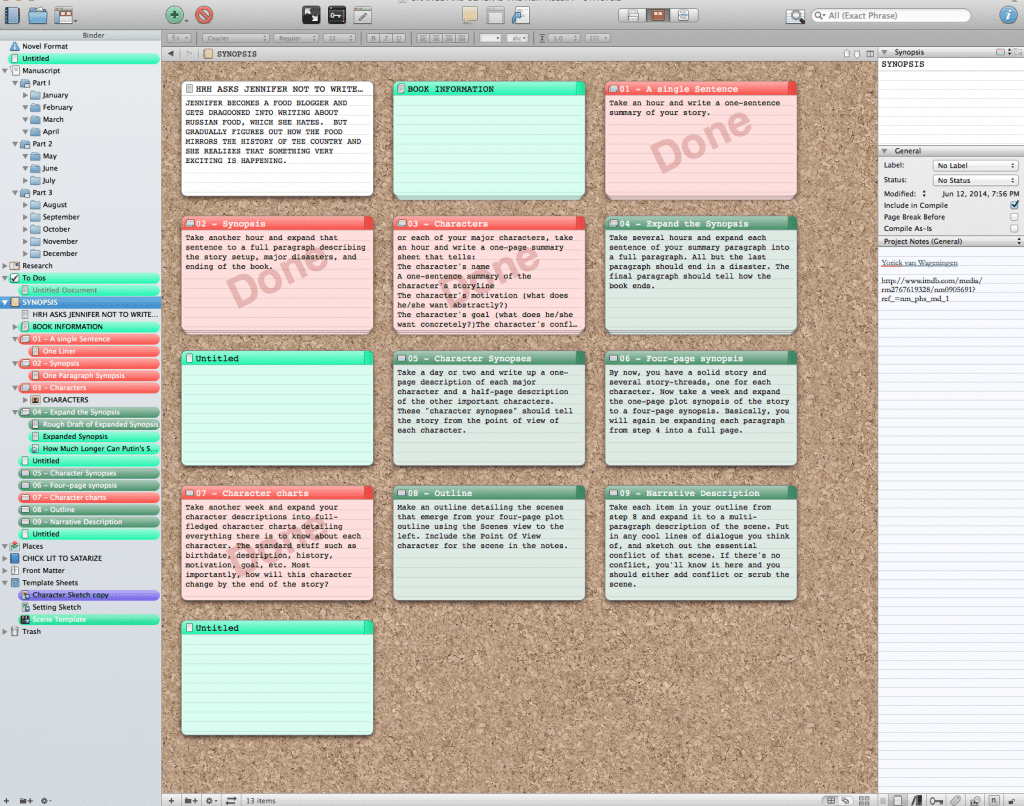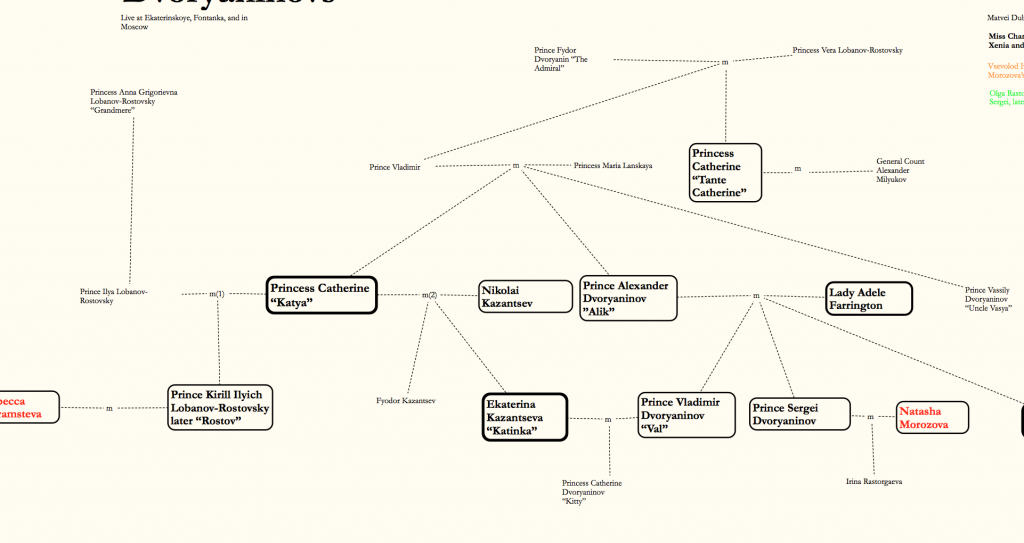There is nothing like the beginning of a venture like NaNoWriMo: all excitement and determination! 50,000 words in 30 days will be a breeze!
But will you feel the same in one week’s time? Possibly not. And in two weeks’ time? Or three?
Happily this year, November 1st falls on a Saturday, and for those of us living in Russia, we’ve got an extra two days of holidays on Monday and Tuesday. This provides an ample opportunity to take a few hours to plan and put some things in place that will enable you to tackle that daily word count with gusto!
1. Scrivener
If you aren’t working with Scrivener, you are missing out!
Crafted with writers and only writers in mind, this intuitive program helps you organize your thoughts in corkboard, outline, or text format. Project target windows motivate you to stay on track, while handy drag-and-drop options make organizing your thoughts a breeze.
Scrivener automatically backs up your work and you can cache unwanted snippets in a trash that asks you about 400 times if you, really, really want to empty it. But the best thing about Scrivener is that it helps you outline and plan a book so that you come to the page focused and ready to tell your story. For you mind mappers out there, Scrivener’s cousin software Scapple is a great tool for outlining ideas, plots, and relationships, which you can save and import to Scrivener!
I can’t say enough about how Scrivener has changed the way I write: making me more efficient, more organized, and far more focused than I ever was. I compose pretty much everything from blog posts like this one to full-length books in Scrivener. If you are halfway through a manuscript, no problem! I uploaded all the material for Lenin Lives Next Door: Marriage, Martinis, and Mayhem in Moscow
to Scrivener and I immediately benefitted, including bringing together material that was too top-heavy for the book and re-purposing it into Have Personality Disorder, Will Rule Russia: A Concise History of Russia, which I also outlined and wrote in Scrivener.
2. Find A Place to Write:
I find writing at home incredibly distracting. I get what Elizabeth Gilbert means when she wonders, “Does Philip Roth ever stop what he’s doing and put the guest room sheets into the dryer?” Home is full of time sucker traps so it’s important to find what Starbucks calls “the third place.” For me, sometimes it’s the Starbucks next door to my house in Moscow, but I find the best place to work is a library. I used to feel very sorry for myself that I wasn’t able to access a proper library in Moscow, but you know what? I was wrong! It took me 10 minutes and 100 rubles (about 25 cents) to acquire a “Reader Ticket” to the State Russian Library in Moscow and now I have access to over 15 readers’ rooms filled with other geeks just like me. It’s inspiring – from the statue of a somber Dostoyevsky outside (no pressure!) to the amazing view from the third-floor reading room window, and I get a lot done there.
So find a cafe or a library – whether it is your local public library or the library of a college or university in your area. Review the rules and regulations concerning food & drink and laptops etc. and be sure to follow them to the letter.

This is a very inspiring view outside the window of the State Russian Library reading room where I work.
3. Get Rid of Distractions
Leaving home helps, sure, but Wifi lurks around every corner. I use Anti-Social to block my access to Facebook and Twitter, as well as other tempting websites, which I can customize in the newest version of Anti-Social. This is the best ten bucks I ever spent, and I recommend you spend it as well. If you want to remove yourself completely from the temptations of the World Wide Web, you can purchase software called Freedom, which blocks you completely from the Internet. This can work against you, however, if you need the Internet to research topics related to your book. When I need to be completely distraction proof, I head to a place where I have no Internet access whatsoever, like the Smith College Library when I’m in America.
4. Learn More about the Craft of Fiction Writing
If this is your first or even your fiftieth novel, you can always learn more about the craft of writing. I could go on for hours about great books on writing, but NaNoWriMo is a race against time so here is the shortlist:
How Fiction Works by James Wood
by James Wood
This is the ultimate primer on how fiction is crafted. Wood uses examples of all kinds of writing from the ducks in Make Way For Ducklings to P.G. Wodehouse’s Jeeves and his hapless master, Bertie Wooster. This is a quick but essential read!
20 Master Plots: And How to Build Them
If you are new to writing or fiction and you struggle with structure, dip into this highly readable treatment of classic plot skeletons. Tobias won’t tell you how to tell your story, but he’ll help you understand the markers along the way — what your hero or heroine, their wing guys and gals and mentors, and the all-important antagonist should be doing and when.
How to Write a Novel Using the Snowflake Method (Advanced Fiction Writing Book 1) by Randy Ingermanson
by Randy Ingermanson
If, like me, you fall somewhere between a “plotter” — someone who outlines and plans her novel in excruciating detail and a “pantser” — someone who just sits down and lets the story flow, then this could be the method for you. Ingermanson takes you through his method of building a story, its world, and its population in a logical progression that helps you think carefully about your story before you even write it.
I am currently working through these steps and it has been a fascinating journey. What I thought in May would be, as I glibly described it to HRH (my “Handsome Russian Husband”) “a quick and light thing to throw up on Kindle” has become a very substantive work of fiction, in which characters from Lenin Lives Next Door are confronting some really difficult issues. The plot is much tighter and much more pleasing than I expected it could be, and I know that this is a result of using Inger Manson’s method.
The Emotion Thesaurus: A Writer’s Guide To Character Expression
There is nothing like a Thesaurus. I own about ten. I would be lost in the kitchen without The Flavor Bible: The Essential Guide to Culinary Creativity, Based on the Wisdom of America’s Most Imaginative Chefs and I would be lost in my writing without The Emotion Thesaurus.
This well-organized volume offers writers physical signals, internal sensations, mental responses, and cues for how characters afflicted with a particular emotion may react. I find this particularly helpful in making antagonists more 3-dimensional, pulling them away from stereotypes and making them much more enjoyable for the reader.
Write Your Novel From The Middle: A New Approach for Plotters, Pantsers and Everyone in Between by James Scott Bell
by James Scott Bell
This is another approach to plotting a novel, and one that I am implementing in my 2015 project — a lengthy and rather rambling historical saga trilogy set in revolutionary Russia, which is in the planning and research stage. Write Your Novel from the Middle is helping me craft workable story arcs. James Scott Bell argues — convincingly, I think — that if you begin with a detailed understanding of the crisis point, you can work backward to the beginning and forward to the end. His metaphor of a chain link bridge is a great way to sketch out your novel to ensure that the pace is appropriate and balanced.
The Elements of Style, Fourth Edition by Strunk and White
by Strunk and White
Don’t leave home without it.
5. Get Your Team On Board and Your Ducks in Order!
NaNoWriMo is all about what writers call “bum in seat” time — you have to carve out significant time to spend writing. Remember, NaNo is all about logging 50K plus words — the editing comes later. It’s not about agonizing about every description of every sunrise or sunset — no, it’s about coaxing your characters to come out of the shadows of your mind and take their rightful places on the page.
NaNo won’t work if you don’t put in the “bum in seat” time, and to do that, you have to plan ahead.
Let those close to you know that you are gearing up for this special month of creativity. If appropriate, ask those you live with to temporarily take on some of the chores and responsibilities you usually shoulder. Ask for their support. Be clear about your intentions. For example, my parents are very generously hosting our extended family for a beach holiday in November. I’m very grateful for the time we will spend together and the opportunity for us all to recharge our batteries. However, I let everyone know that I would be spending 2-3 hours in the morning on my writing, and I’m delighted to say that everyone is on board.
You may also have to give up things you might otherwise enjoy during November. I’ve decided to limit my TV to 4 hours a week, and only when I am exercising (an incentive I hope will have all kinds of good results). I’m traveling a lot this month, but I’m planning my days so that I can fit in 2 – 3 hours of writing a day. I also hope I can be disciplined about using the time on planes and trains to get work done.
NaNoWriMo is a global event with writing meet-ups in cities around the world. Find a group near you, or find a group in a city you are visiting and settle in for some quality writing time with others on this journey of discovery and creativity.
Ready to write?







